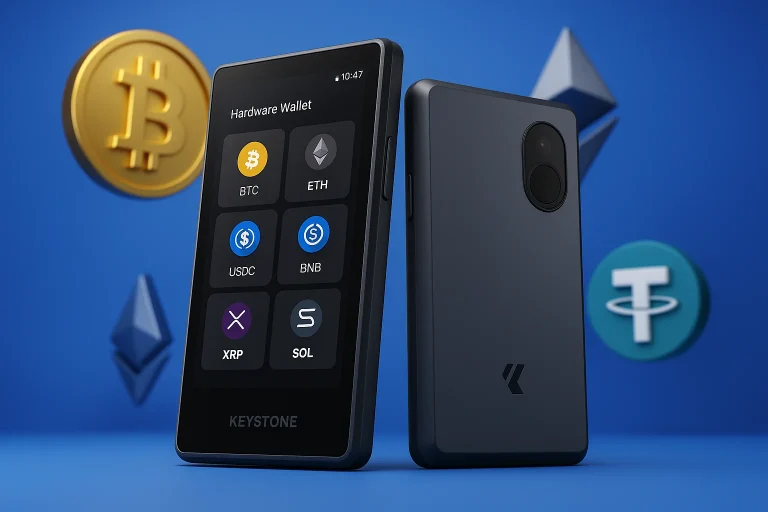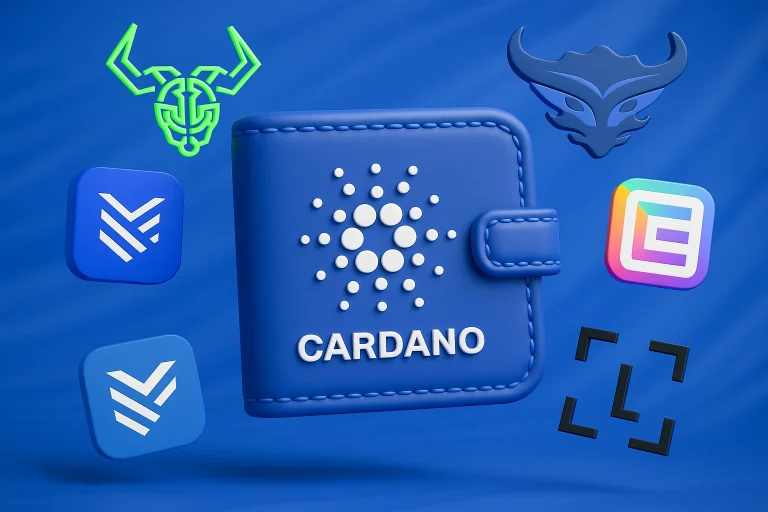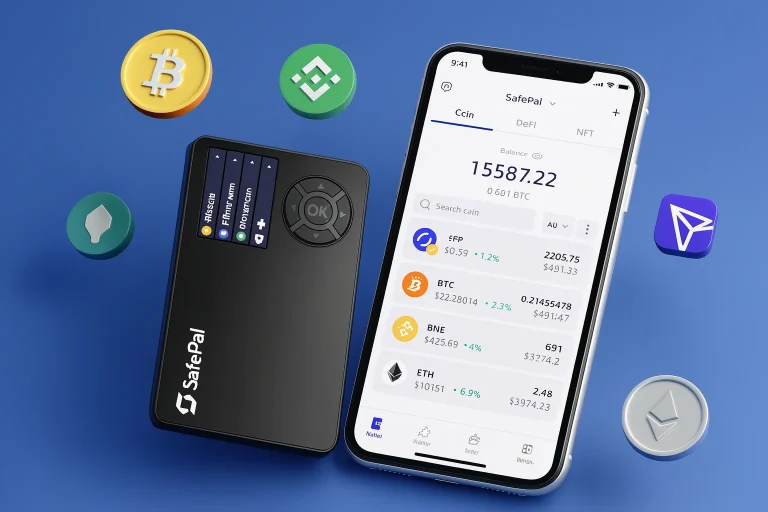Using just one private key to protect your crypto isn’t safe anymore. Hacks, human error, and shared ownership make single-key wallets too risky.
If you run a DAO, hold Bitcoin long-term, or manage a shared treasury, losing access or having just one point of failure can be costly.
Multisig wallets fix this by requiring multiple participants to approve every transaction. This layer of protection helps protect against online threats and a compromised key. In this guide, we’ve picked the best multisig wallet options for 2025, whether you need personal security or enterprise-level control.
Table of contents
- 1. Safe: Best Overall Multisig Wallet
- 2. Casa: Best Bitcoin Multisig for Individuals & Families
- 3. Electrum: Best Bitcoin Multisig for Power Users
- 4. Fireblocks: Best for Institutions, Staking & Cross-Chain Bridging
- 5. Keystone 3 Pro: Best Hardware-Based Multisig Security
- What is a Multisig Wallet?
- How to Stake with a Multisig Wallet
- How to Choose the Right Multisig Wallet
- FAQ
- Final Thoughts
Key Takeaway
Multisig wallets provide enhanced security, shared control, and built-in redundancy, making them ideal for:
- Crypto investors;
- DAOs and Web3 startups;
- Institutions managing shared digital assets.
The global multisig wallet market was valued at $1.27 billion in 2024, and is projected to grow to $4.37 billion by 2033, at a 15% CAGR. As digital asset adoption rises, so does the need for robust wallet security.
Quick Summary: Top 5 Multisig Wallets |
|
|---|---|
| Safe | Best For: DeFi users, DAOs, and Ethereum-focused teams. Supported Chains: 14+ EVM-compatible chains, including: Ethereum, Polygon, Arbitrum, Optimism, and others. Notable Features: Smart contract-based multisig, DeFi integrations, customizable policies. Price: Free (gas fees apply). |
| Casa | Best For: Bitcoin holders, families, and inheritance planning. Supported Chains: Bitcoin only. Notable Features: 3-of-5 multisig, inheritance planning, mobile apps. Price: Standard ($21/mo), Premium ($175/mo), Private Client Custom Pricing. |
| Electrum | Best For: Technical users and Bitcoin power users. Supported Chains: Bitcoin only. Notable Features: Open-source, hardware wallet integration, custom scripts. Price: Free. |
| Fireblocks | Best For: Institutions, enterprises, and high-volume traders. Supported Chains: 40+ blockchains including Bitcoin, Ethereum, and Solana. Notable Features: MPC technology, institutional custody, API access. Price: Essentials ($4,200/ year), Pro ($13,800/ year), and custom enterprise pricing. |
| Keystone 3 Pro | Best For: Security-conscious users wanting hardware-based multisig. Supported Chains: 5,500+ cryptocurrencies across major networks. Notable Features: Air-gapped security, QR code transactions, fingerprint authentication. Price: $149 (hardware device). |
1. Safe: Best Overall Multisig Wallet
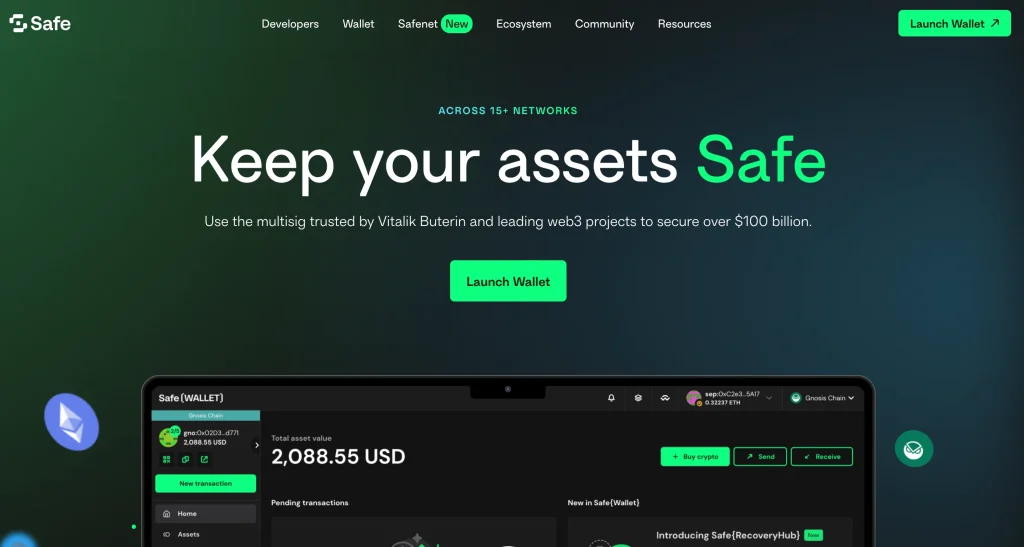
Safe (formerly Gnosis Safe) is a multi-signature smart contract wallet primarily designed for Ethereum and EVM-compatible chains. It allows users to set up customizable multi-sig configurations with a user-friendly interface.
Specifications |
|
|---|---|
| Multisig Setup | Flexible M-of-N (1-50 owners supported) |
| Architecture | Smart contract wallet on EVM chains |
| Transaction Batching | Multiple operations in a single transaction |
| Module System | Extensible with custom modules |
| Hardware Integration | Ledger, Trezor, Keystone compatibility |
| API Access | Safe Core SDK, REST APIs |
| Mobile Apps | iOS, Android with WalletConnect |
2. Casa: Best Bitcoin Multisig for Individuals & Families

Casa offers a secure and easy-to-use multisig solution for Bitcoin holders. It simplifies key management without giving up user control. With inheritance planning and premium support, it protects long-term wealth.
Specifications |
|
|---|---|
| Key Architecture | 3-of-5 multisig (fixed configuration) |
| Key Distribution | User: 2 mobile + 2 hardware, Casa: 1 server key |
| Hardware Wallets | Ledger Nano S/ Nano X, Trezor Model T |
| Mobile Security | Biometric authentication, PIN protection |
| Inheritance Setup | Beneficiary designation with a 6-month delay |
| Key Rotation | Automated key replacement service |
| Support Channels | Email, phone, and video calls included |
3. Electrum: Best Bitcoin Multisig for Power Users
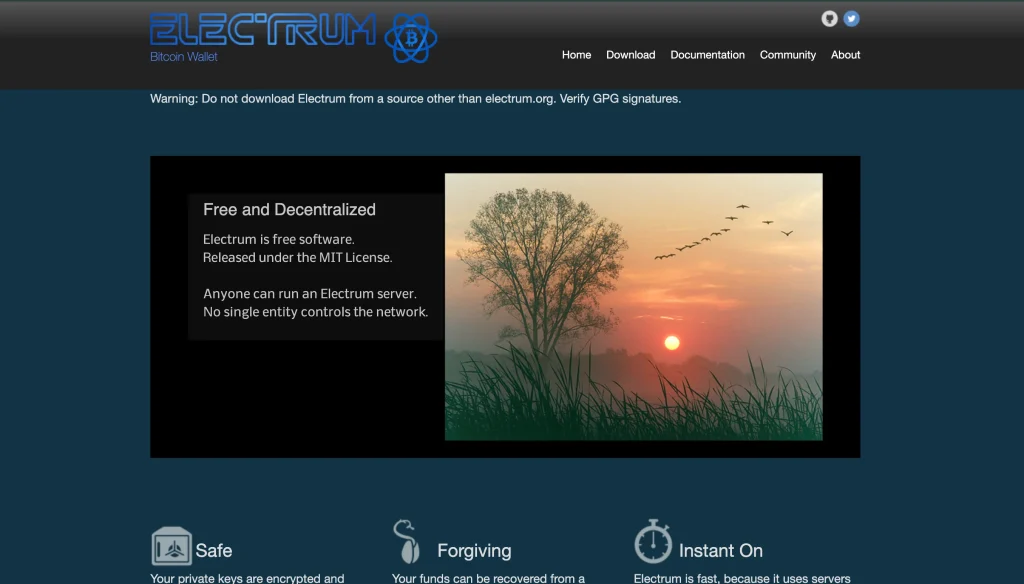
Electrum is the go-to wallet for advanced Bitcoin users who want full control over their multi-sig setup. Its open-source design and rich customization options offer unmatched flexibility. Power users value its ability to support custom setups and hardware wallet integration.
Specifications |
|
|---|---|
| Multisig Options | Any M-of-N configuration (up to 15 cosigners) |
| Script Types | P2SH, P2WSH, P2SH-P2WSH support |
| Transaction Building | Partial signing with PSBT support |
| Hardware Support | 10+ hardware wallet brands |
| Server Options | Personal server, Tor support |
| Plugin System | Lightning Network, CoinJoin extensions |
| Operating Systems | Windows, macOS, Linux, Android |
4. Fireblocks: Best for Institutions, Staking & Cross-Chain Bridging
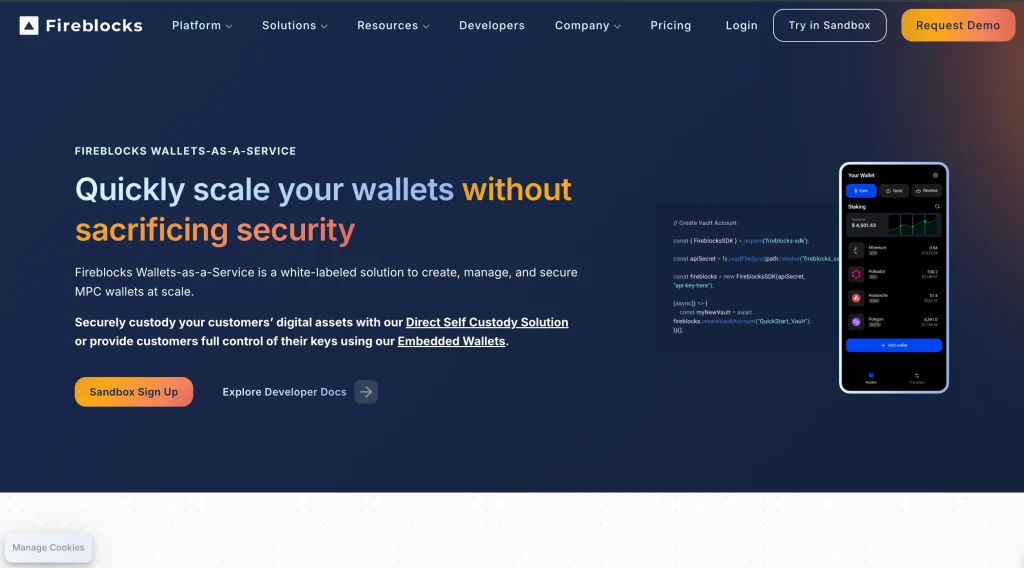
Fireblocks is an all-in-one solution for managing and securing digital assets. It streamlines treasury operations, connects to exchanges and DeFi platforms, and supports secure trading. It is ideal for teams handling large-scale crypto activity.
Specifications |
|
|---|---|
| Security Model | MPC-CMP with secure enclaves. |
| Key Shares | 3-party computation (customer, Fireblocks, backup) |
| API Framework | REST APIs with webhooks. |
| Compliance | SOC 2 Type II, ISO 27001 certified. |
| Insurance Coverage | Lloyd’s of London policy. |
| Role Management | Granular permissions, admin controls. |
| Network Monitoring | 24/7 threat detection. |
5. Keystone 3 Pro: Best Hardware-Based Multisig Security
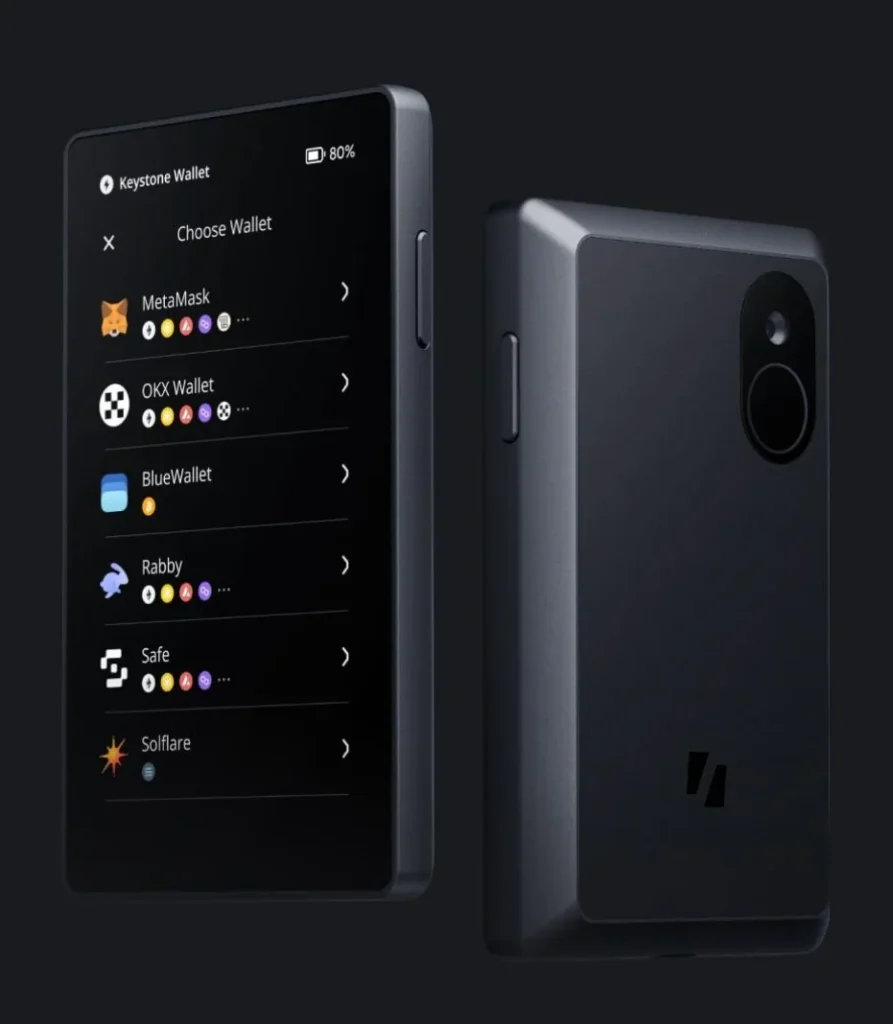
The Keystone 3 Pro is a fully air-gapped device that only communicates via QR codes and a microSD card. It supports up to three distinct recovery phrases, enabling users to manage multiple wallets seamlessly from a single device.
Specifications |
|
|---|---|
| Processor | ARM Cortex-M33 secure element |
| Display | 4-inch IPS touchscreen |
| Biometrics | Fingerprint sensor with secure storage |
| Communication | Air-gapped, QR code only |
| Multi-Wallet | 3 independent wallet slots |
| Battery | 1800mAh rechargeable lithium |
| Build Material | Aircraft-grade aluminum body |
What is a Multisig Wallet?
A multi-sig (multi-signature) wallet is a cryptocurrency wallet that requires more than one signature from multiple individuals to approve a transaction, instead of just one, like traditional wallets.
Think of it like a bank vault that needs several public keys from different people to open. No single person can access the funds alone.
How Multisig Wallets Work?
Multisig wallets use a system called “M-of-N”, where:
- M = minimum number of signatures needed to approve a transaction. (require multiple signatures)
- N = total number of keys in the wallet.
Example: In a 2-of-3 setup, any 2 of the 3 key holders must approve a transaction for it to proceed.
Set up and transaction process
- Users create multiple private keys and set the required signing threshold.
- The wallet creates a unique multisig address linked to all keys.
- To send funds, one key holder starts a transaction and signs it.
- The partially signed transaction is then shared with other key holders.
- Once the required signatures are collected, the transaction is valid and sent to the blockchain.
Common multisig setups
| Setup | Use Case | Key Benefit |
| 2-of-3 | Personal backup, small teams | Access funds even if one key is lost. |
| 3-of-5 | Startups, DAOs | Higher security with redundancy. |
| 2-of-2 | Joint bank accounts | Mutual approval; no access without both. |
| 5-of-9 | Enterprises, treasury management | Strong governance and security control. |
How to Stake with a Multisig Wallet
Staking from a multisig wallet offers added security but requires coordination between signers. The process depends on the blockchain and staking method used.
Here’s a streamlined overview of the most common approaches:
1. Direct On-Chain Staking
Some networks (like Ethereum 2.0) support staking directly from a multisig wallet.
Example: Using Safe with Lido or Rocket Pool, where all wallet signers must approve the staking transaction and any validator-related updates.
Best for Ethereum users, DAOs and teams, and those seeking non-custodial staking.
2. Delegated Staking
You can delegate tokens from a multisig to a validator on networks like Cosmos, Solana, or Cardano.
Your funds stay secure in the wallet while rewards are automatically distributed.
Key benefits: Funds remain under multisig control; Easy reward collection; Low maintenance once set.
3. Liquid Staking with Multisig
Platforms like Lido or Marinade allow you to stake and receive liquid tokens (e.g., stETH, mSOL) that earn rewards while remaining usable in DeFi.
Why it works for multisig: It allows governance approval for staking, keeps assets usable, and adds flexibility to treasury management.
4. Enterprise-Grade Staking
Solutions like Fireblocks offer secure staking infrastructure tailored to institutions.
They handle validator setup, compliance, and slashing protection, while funds remain protected by MPC/multi-sig frameworks.
Best for enterprises, custodians, and high-volume staking operations.
Important tips for multisig staking:
- Educate all signers about lock-up periods and staking risks;
- Choose audited validators and reputable platforms;
- Plan to coordinate signatures on time;
- Keep backup procedures in place for key loss or signer unavailability.
How to Choose the Right Multisig Wallet
Choosing the right multisig wallet depends on your needs, security preferences, and the blockchain networks you use.
- Casa and Electrum are top picks for Bitcoin users and are straightforward yet powerful.
- If you focus on Ethereum or DeFi, Safe (formerly Gnosis Safe) is the standout choice.
- Running a business or managing institutional assets? Fireblocks offers robust, enterprise-grade protection.
- Want maximum security? Keystone’s hardware-based multisig provides air-gapped signing and enhanced peace of mind.
However, here are some key factors to consider:
1. Supported Blockchains
Check which blockchains the wallet supports. If you mainly use Bitcoin, wallets like Casa or Electrum are ideal. Safe is a top choice for Ethereum and EVM-compatible chains. Institutions may prefer Fireblocks for its extensive cross-chain support.
2. Security Features
Look for wallets with strong security, such as multi-factor authentication, hardware wallet compatibility, or air-gapped signing (like Keystone 3 Pro). Also, consider whether the wallet is open-source and audited, which adds transparency and trust.
3. User Experience
Evaluate the ease of use. Beginners might prefer wallets with a simple setup and mobile apps like Casa. Advanced users may want full customization options available in Electrum. Team collaboration features like built-in approval workflows are useful for DAOs and businesses.
4. Cost and Pricing Model
Some multisig wallets are free (excluding blockchain gas fees), while others charge monthly or yearly subscriptions. Enterprise solutions like Fireblocks have higher costs but provide additional services and support. Hardware wallets require an upfront purchase.
5. Customization and Flexibility
Consider how much control you want over multisig configurations. Some wallets offer fixed setups (e.g., Casa’s 3-of-5), while others allow fully customizable “M-of-N” signatures, suitable for complex organizational needs.
6. Recovery and Backup Options
Good multisig wallets provide key recovery or inheritance planning features. This ensures you don’t lose access if a key is lost or a signer becomes unavailable.
7. Integration with DeFi and Staking
If you plan to stake assets or use DeFi apps, check if the wallet integrates with popular protocols or staking services. Safe and Fireblocks offer robust DeFi and staking features, making them great for active crypto users and institutions.
FAQ
Are Multisig Wallets Safe?
Yes, multisig wallets are safer than single-key wallets. They require multiple approvals to access funds, reducing the risk of hacks or key loss. Security depends on proper key storage and trusted wallet providers.
What Is the Difference Between Multisig and MPC Wallets?
Multisig uses multiple complete private keys to sign a transaction. MPC splits one key into encrypted shares, with no one holding the whole key. Multisig is transparent and on-chain; MPC offers better privacy and flexibility.
What Are the Advantages of Multisig Wallets?
Enhanced Security: Multisig removes single points of failure. Funds stay safe even if one key is compromised unless the required number of keys is used.
Shared Control: Multiple users share access without a single person having complete control. This is perfect for teams, families, or organizations managing shared funds.
Recovery Options: If one key is lost, the others can still approve transactions. This reduces the risk of permanently losing access to your assets.
Governance & Compliance: This function supports approval workflows and maintains a complete audit trail, helping organizations meet internal policies and regulatory standards.
Inheritance Planning: Distribute keys to trusted people so assets remain accessible if the primary holder becomes unavailable. This is ideal for secure estate planning.
How To Withdraw From a Multisig Wallet?
Withdrawing from a multi-sig wallet requires approval from multiple keyholders based on the wallet’s set threshold.
- Initiate Transaction: One key holder creates a withdrawal request.
- Collect Signatures: The request is shared with other key holders for approval.
- Broadcast Transaction: The transaction is sent to the blockchain after collecting enough approvals.
- Confirmation: Funds are transferred once the network confirms the transaction.
The exact steps may vary slightly depending on the wallet, but multisig wallets always require multiple approvals before releasing funds.
Final Thoughts
The best multisig wallet in 2025 is all about control, coordination, and security. Whether you’re managing personal funds or shared assets, multisig wallets bring peace of mind through shared approvals and flexible governance.
As crypto grows, smart users upgrade their wallets. With the proper multi-sig setup, you’re not just protecting assets, you’re building a future-proof crypto strategy.


